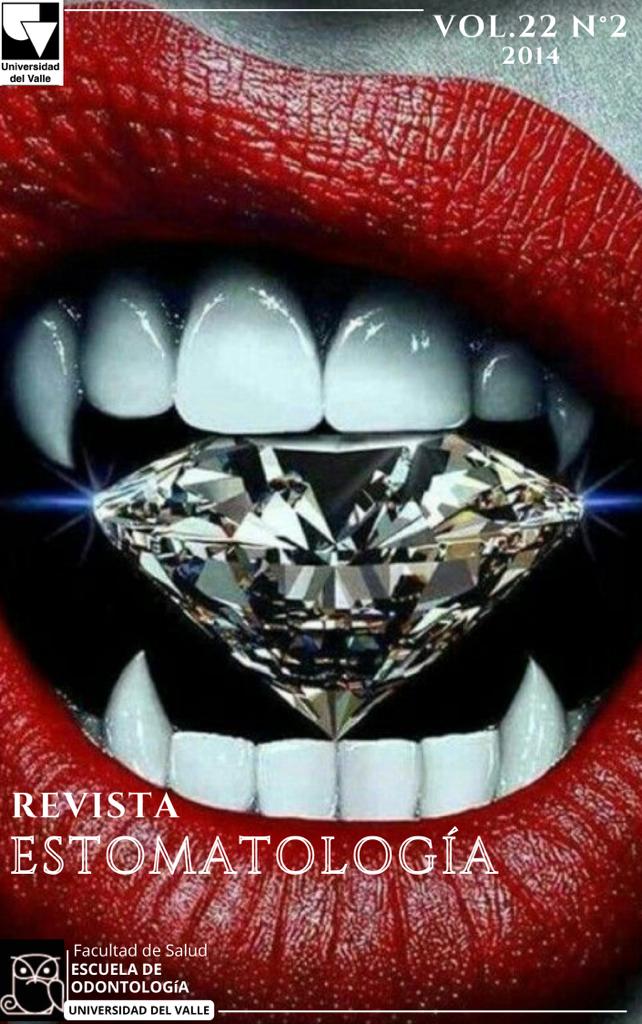Evaluation of success and/or failure of endodontic treatment in non-vital teeth performed at the School of Dentistry at the Universidad del Valle. Case series
Keywords:
Non-vital tooth, teeth endodontically treated, dental pulp necrosis, periapical periodontitisMain Article Content
Introduction: The endodontic treatment in non-vital teeth is directed to the elimination of the infection through the biofilm removal biomechanics and remnants of necrotic tissue, in order to eliminate infection and generate periapical tissue repair.
Objective: To determine the success or failure of endodontic treatment in non-vital teeth performed by dental students under supervision.
Materials and methods: In this article 3 clinical cases of patients undergoing endodontic procedures with non-vital pulps track 4 and 6 years are presented.
Results: Two of the 3 cases show a process of incomplete periapical tissue regeneration at the time of observation. The third case shows a process of subsequent periodontal disease to endodontics leading to tooth loss.
Conclusions: Is necessary to conduct a study with a sample size calculated to determine what percentage of success and failure of endodontic treatment in non-vital teeth, performed by undergraduate dental students under supervision, and to determine those factors that directly influence both outcomes.
treatment. Clin Cosmet InvestigDent 2014; 8(6):45-56.
2. Baziar H, Daneshvar F, Mohammadi A, Jafarzadeh H. Endodontic management of a mandibular first molar with four canals in a distal root by using cone-beam computed tomography: a case report. J Oral Maxillofac Res 2014; 5(1):1-5.
3. Siqueira J, Rocas I. Clinical Implications and Microbiology of Bacterial Persistence after Treatment procedures. J Endod 2008; 34(11):1291-301
4. Estrela C, Holland R, Estrela C, Alencar AH, Sousa-Neto MD, Pécora JD. Characterization of successful root canal treatment. Braz Dent J 2014; 25(1):3-11.
5. Migliau G, Pepla E, Besharat LK, Gallottini L. Resolution of endodontic issues linked to complex anatomy. Ann Stomatol 2014; 5(1):34-40.
6. Lin L, Ricucci D, Lin J, Rosenberg P. Nonsurgical Root Canal Therapy of Large Cyst-like Inflammatory Periapical Lesions and Inflammatory Apical Cysts. Journal of Endodontics 2009; 35(5):607-15.
7. Dammaschke T, Steven D, Kaup M, Heinrich K. Long-term Survival of Rootcanal– treated Teeth: A Retrospective Study Over 10 Years. J Endod 2003; 29(10):638-43.
8. Jiménez A, Segura J. Valoración clínica y radiológica del estado periapical: registros e índices periapicales. Endodoncia 2003; 21(4):220- 8.
9. Stoll R, Betke K, Stachniss V. The Influence of Different Factors on the Survival of Root Canal Fillings: A 10-Year Retrospective Study. J Endod 2005; 31 (11):783-90.
10. Santos S, Soares J, Costa G, Brito- Júnior M, Moreira A, MagalhãesC. Radiographic Parameters of Quality of Root Canal Fillings and Periapical Status: A Retrospective Cohort Study. J Endod 2012; 36(12):1932-37.
11. Friedman S. Considerations and concepts of case selection in the management of post-treatment endodontic disease (treatment failure). Endodontic Topics. 2002; 1:54-78.
12. Moreno J, Álves F, Gonçalves L, Martinez A, Rôças I, Siqueira, J. Periradicular Status and Quality of Root Canal Fillings and Coronal Restorations in an Urban Colombian Population. J Endod 2013; 39(5):600-4.
13. Gutmann J, Baumgartner J, Gluskin A, Hrartwell G, Walton R. Identify and Define All Diagnostic Terms for Periapical/ Periradicular Health and Disease States. J. Endod 2009; 35(12):1658-74.
14. Saraf PA, Kamat S, Puranik RS, Puranik S, Saraf SP, Singh BP. Comparative evaluation of immunohistochemistry, histopathology and conventional radiography in differentiating periapical lesions. J Conserv Dent 2014; 17(2):164-8.
15. Kajiya M, Giro G, Taubman M, Han X, Mayer M, Kawai T. Role of periodontal pathogenic bacteria in RANKL-mediated bone destruction in periodontal disease. J Oral Microbiol 2010; 2(10):1-16.
16. Henderson B, Curtis M, Seymour R, Donos N. Periodontal Medicine and Systems Biology. First edition. Oxford: John Wiley & Sons 2009.
17. Sánchez-Torres A, Sánchez-Garcés MA, Gay-Escoda C. Materials and prognostic factors of bone regeneration in periapical surgery: A systematic review. Med Oral Patol Oral Cir Bucal 2014; 19 4): 419-25.
18. Socransky S.S, Hafajee A. D, Dental biofilms: difficult therapeutic targets. Periodontology 2000 2002; 28:1255.
19. Sbordone L, Bortolaia C. Oral microbial biofilms and plaque-related diseases: microbial communities and their role in the shift from oral health to disease. Clin Oral Invest 2003; 7:181-8.
20. Armitage G C, Diagnosis and Classification of Periodontal Diseases. Periodontology 2000 2005; 9:9-21.
21. Lombardo T, Marcantonio R, Neto R, Alves M. Porphyromonas endodontalis in chronic periodontitis: a clinical and microbiological cross-sectional study. J Oral Microbiol 2012; 4:1-7.
Downloads
Los autores/as conservan los derechos de autor y ceden a la revista el derecho de la primera publicación, con el trabajo registrado con la licencia de atribución de Creative Commons, que permite a terceros utilizar lo publicado siempre que mencionen la autoría del trabajo y a la primera publicación en esta revista.

